
Real vs. Virtual, or What Does the Ant See?
The lenses and mirrors that we are using in this module come in two basic flavors: convex and concave. The lenses A and B in your Optics Kit are called double convex lenses and have positive focal lengths. They have sides that bulge outwards and, as we saw above, converge light to a focal point. Lens C in your Kit is called a double concave lens and has a negative focal length. The concave lens has sides that bulge inward and diverge light, as shown below for parallel beams incident on the lens.
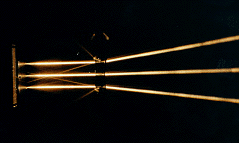
What does it mean for a lens to have a negative or positive focal length? A positive focal length means that the focal point of the lens is on the other side of the lens from where the object is placed. On the other hand, a negative focal length means that the focal point is on the same side of the lens as where the object is placed. This terminology is just a useful convention that allow physicists and engineers to characterize lenses and mirrors; it has no real physical meaning.
But how can we have an image on the same side of the lens as the object?
In an earlier activity, you tried to image (bring to a focus) the room lights with your various lenses. Did you get an image of the lights with your concave lens (Lens C)? Most likely not, since the concave lens, as we have seen, diverges light and can't bring light beams to a focus. The image, if there was one, would have been on the same side of the lens as the source (the light).
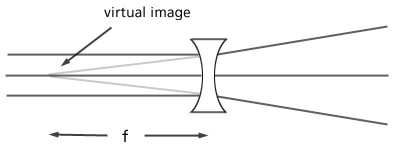
This kind of image on the same side as the source is called a virtual image . It's an image that isn't really there; the focal point in the drawing above is just the point where the rays would converge if they could. We can't focus the beams onto a piece of paper, for instance like you tried earlier. The strange thing about a virtual image, however, is that we can see it!
So what kind of image does a convex lens make? The drawing below show us that a convex (positive) lens forms images on the side of the lens opposite the source .
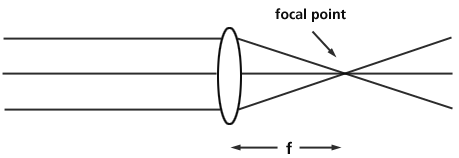
Since we can form an image on a piece of paper, we call this kind of image a real image. As you've probably guessed, we can also see real images.
The mirror tells all
Real and virtual images are not relegated to the domain of just the lenses -- if you want to see another virtual image look in your bathroom mirror. Or in the curved mirror on the passenger side of your car. Virtual images in a mirror form on the image side of a mirror, unlike that of lenses, in which the virtual image forms on the object side of the lens. Again, however, the virtual image is not a true image, in that it cannot be projected onto a screen. This is because the light rays reflecting off a plane mirror never converge, the major criterion for creating a real image. Likewise, light bouncing off a convex mirror never converge, thus these mirrors create virtual images.
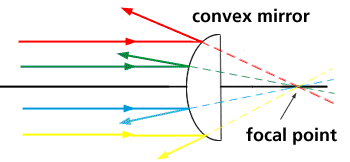
The dotted lines represent the extension of the reflected light rays if they could go through the mirror.
Only concave mirrors can create real images. When light hits the surface of a concave mirror, an individual light ray is reflected at an acute angle and all the light converges at a point on the object side of the mirror.
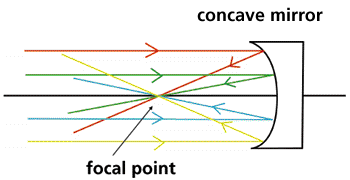
Most real images are seen inverted (upside-down) while virtual images are seen upright. Look in both faces of a well-polished spoon. One surface is a convex mirror, the other is a concave mirror: on which side is your image inverted? upright?
To learn how to find the position and size of an image, go to the Third Installment of our Lenses Readings.
Page authored by the
ACEPT W3 Group
Department of Physics and Astronomy, Arizona State University, Tempe, AZ 85287-1504
Copyright © 1995-2000 Arizona Board of Regents. All rights reserved.